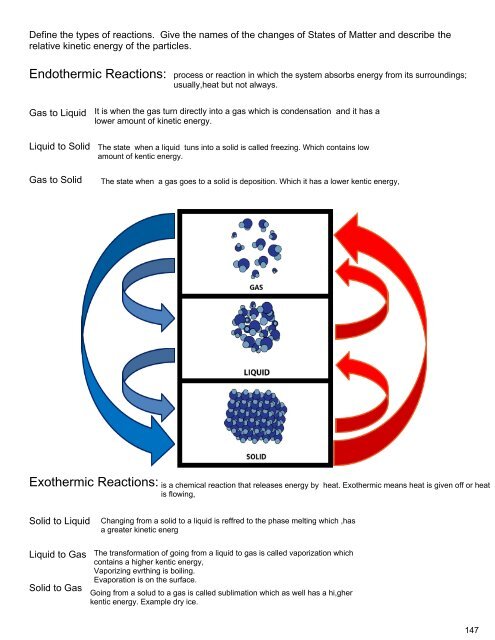Create successful ePaper yourself
Turn your PDF publications into a flip-book with our unique Google optimized e-Paper software.
The following table summarizes the five steps and their results. Each step number is a link back to<br />
the explanation of the calculation.<br />
Converting to kJ gives us this:<br />
1.4832 kJ<br />
24.08 kJ<br />
30.1248 kJ<br />
162.8 kJ<br />
2.9088 kJ<br />
Step q 72.0 g of H2O<br />
1 1483.2 J Δt = 10 (solid)<br />
2 24.08 kJ melting<br />
3 30124.8 J Δt = 100 (liquid)<br />
4 162.8 kJ boiling<br />
5 2908.8 J Δt = 20 (gas)<br />
Summing up gives 221.3968 kJ and proper significant digits gives us 221.4 kJ for the answer.<br />
Notice how all units were converted to kJ before continuing on. Joules is a perfectly fine unit; it's just<br />
that 221,396.8 J is an awkward number to work with. Usually Joules is used for values under 1000,<br />
otherwise kJ is used.<br />
By the way, on other sites you may see kj used for kilojoules. I've also seen Kj used. Both of these<br />
are wrong symbols. kJ is the only correct symbol.<br />
Enthalpy<br />
When a process occurs at constant pressure, the heat evolved (either released or absorbed) is equal<br />
to the change in enthalpy. Enthalpy (H) is the sum of the internal energy (U) and the product of<br />
pressure and volume (PV) given by the equation:<br />
H=U+PV<br />
When a process occurs at constant pressure, the heat evolved (either released or absorbed) is equal<br />
to the change in enthalpy. Enthalpy is a state function which depends entirely on the state<br />
functions T, P and U. Enthalpy is usually expressed as the change in enthalpy (ΔH) for a process<br />
between initial and final states:<br />
ΔH=ΔU+ΔPVΔ<br />
If temperature and pressure remain constant through the process and the work is limited to pressurevolume<br />
work, then the enthalpy change is given by the equation:<br />
ΔH=ΔU+PΔV<br />
Also at constant pressure the heat flow (q) for the process is equal to the change in enthalpy defined<br />
by the equation:<br />
ΔH=q<br />
By looking at whether q is exothermic or endothermic we can determine a relationship between ΔH<br />
and q. If the reaction absorbs heat it is endothermic meaning the reaction consumes heat from the<br />
surroundings so q>0 (positive). Therefore, at constant temperature and pressure, by the equation<br />
above, if q is positive then ΔH is also positive. And the same goes for if the reaction releases heat,<br />
144



